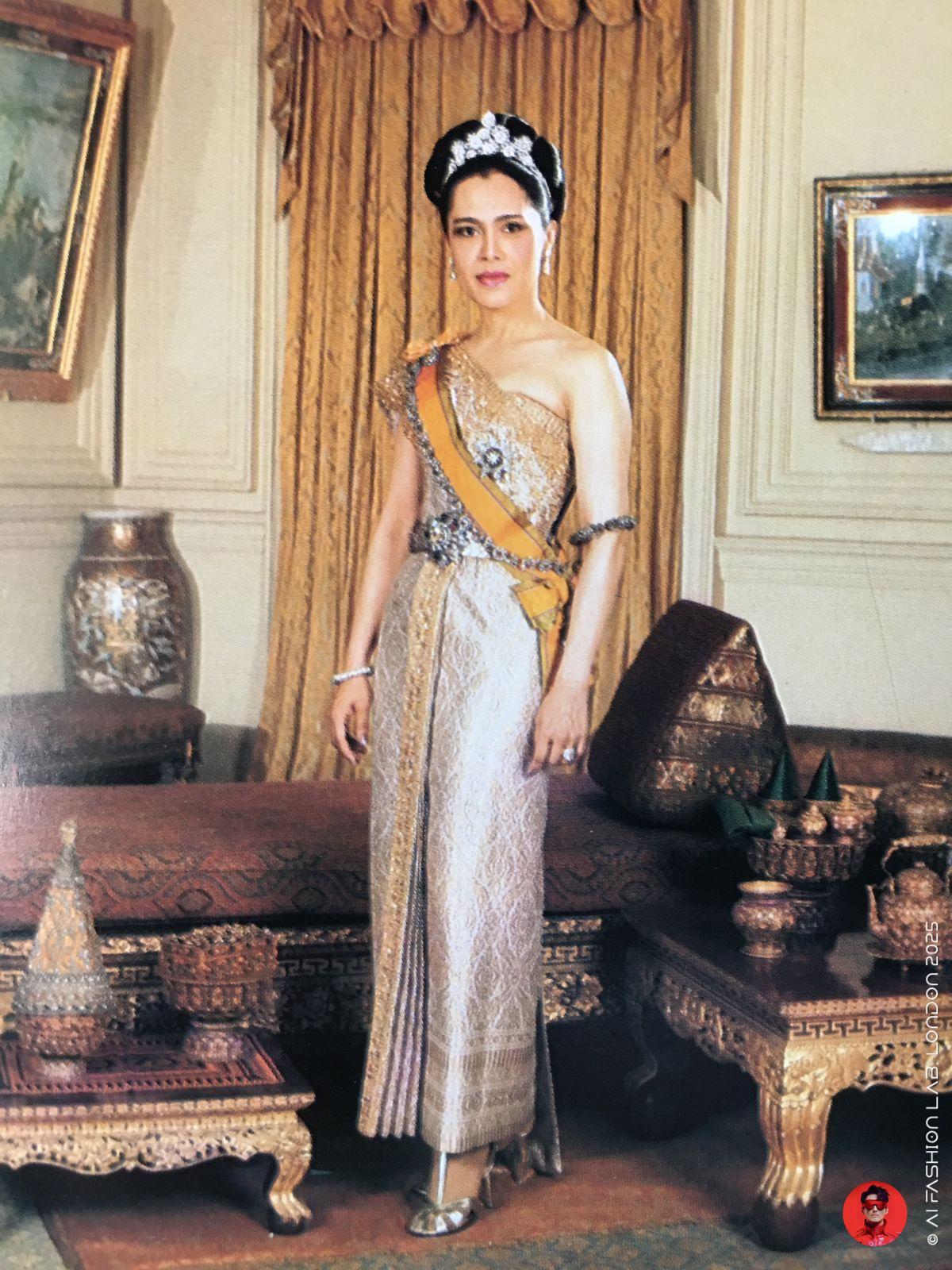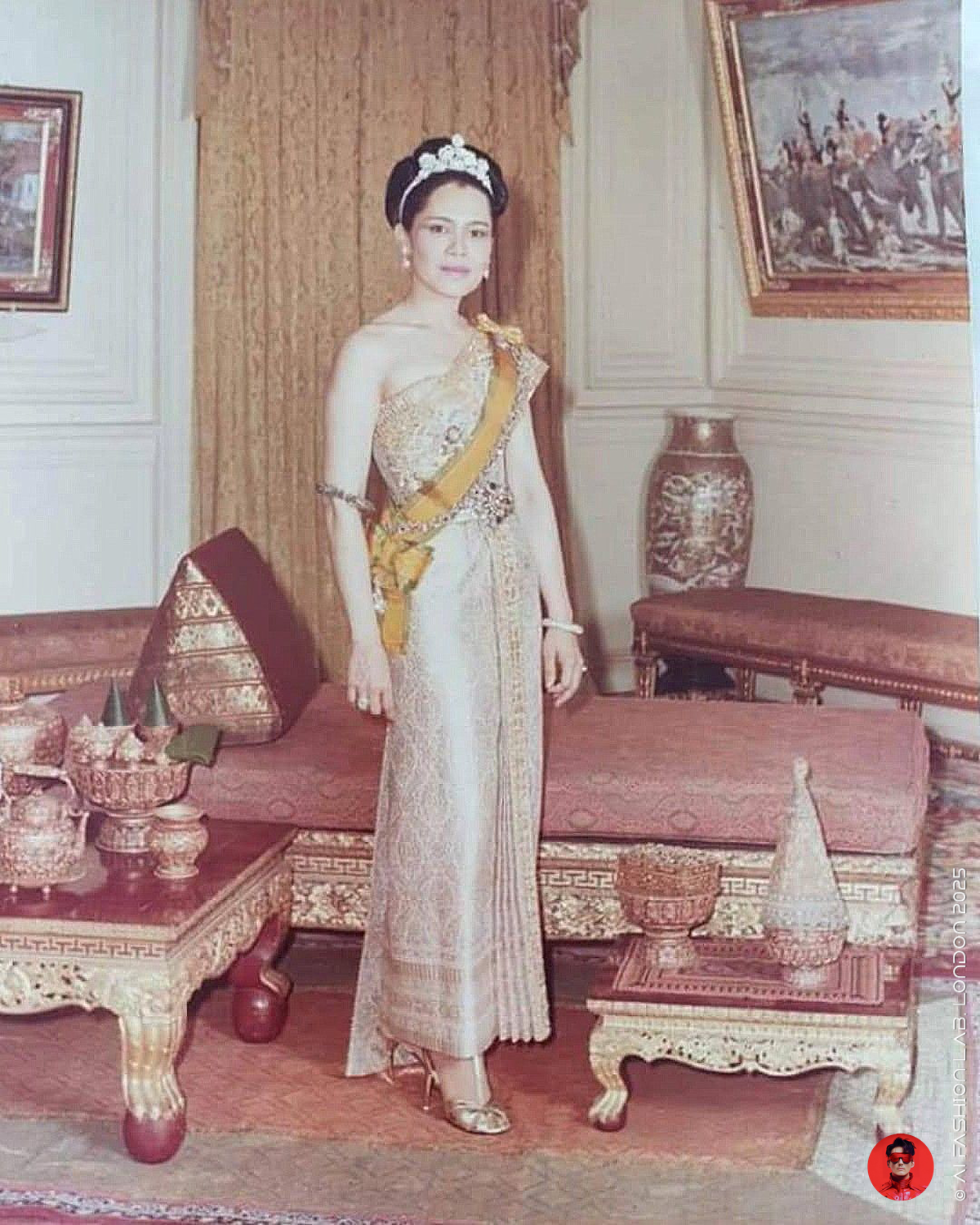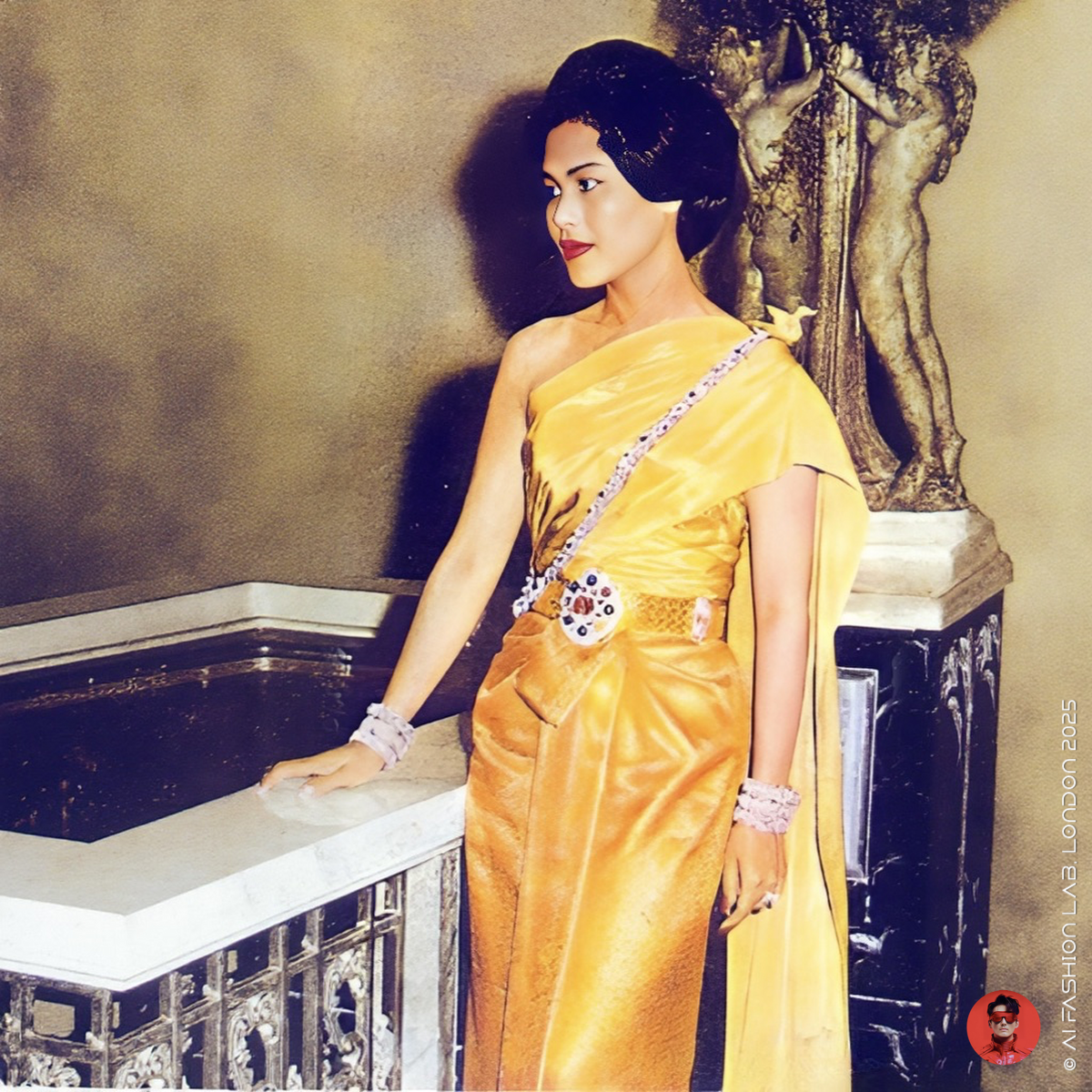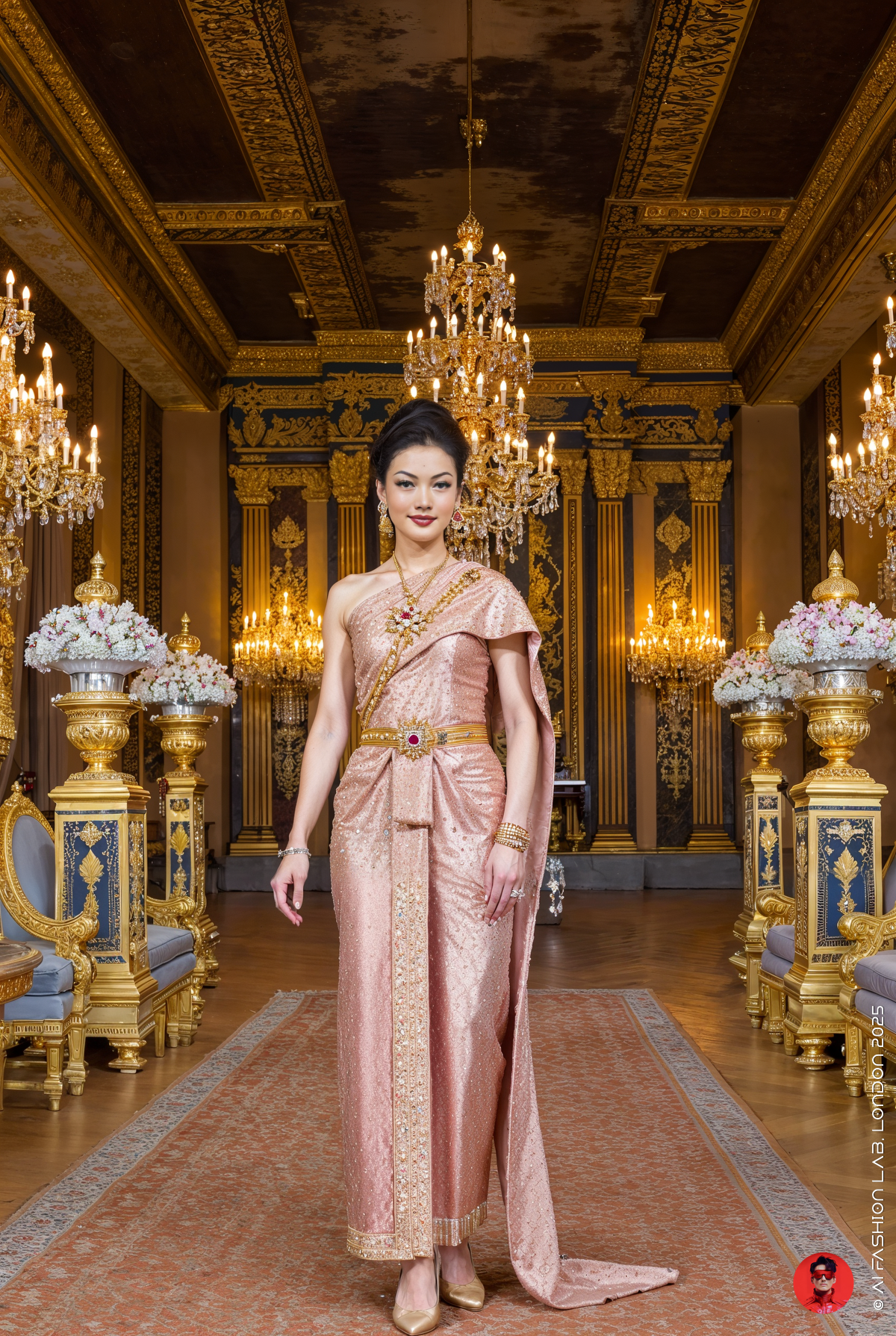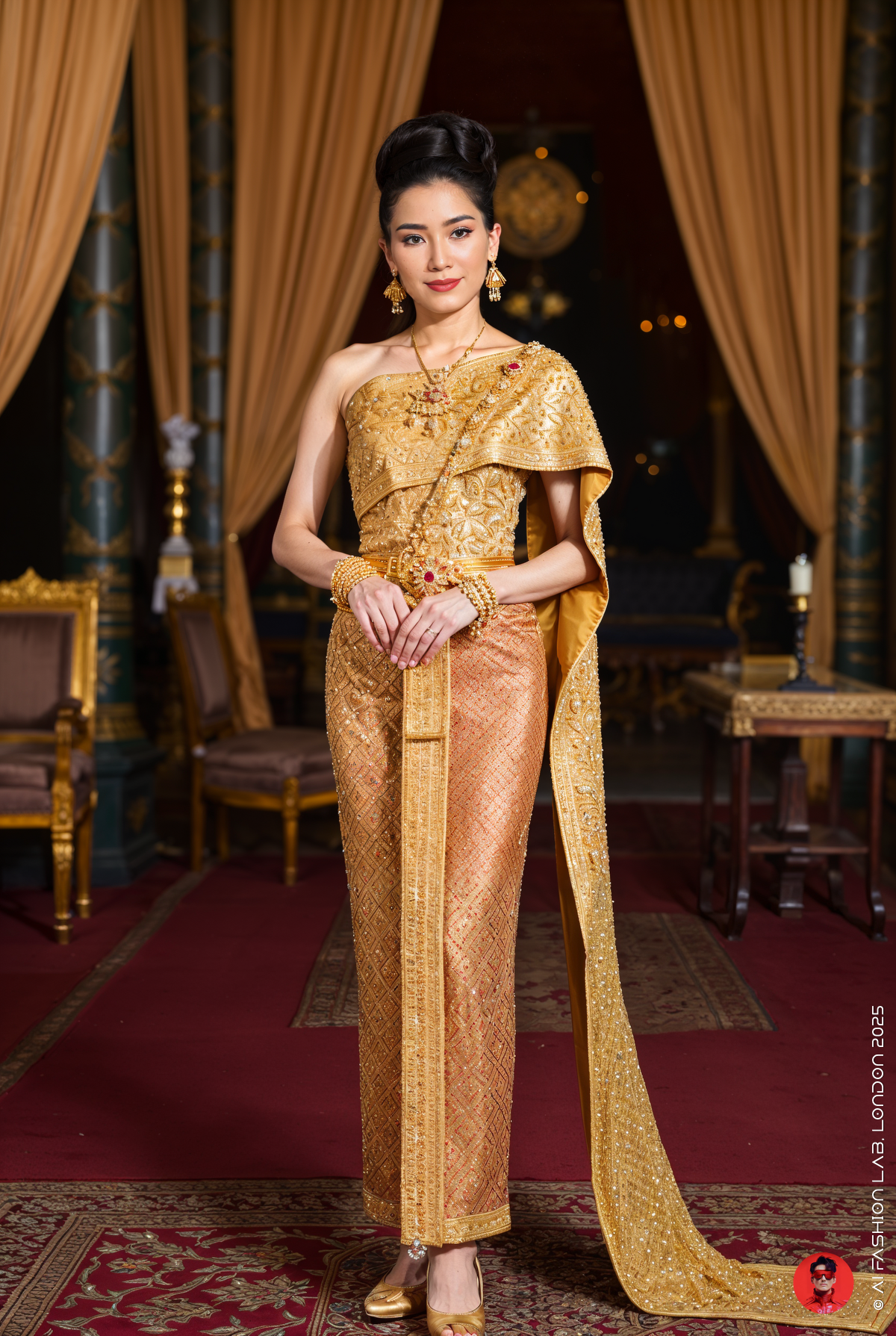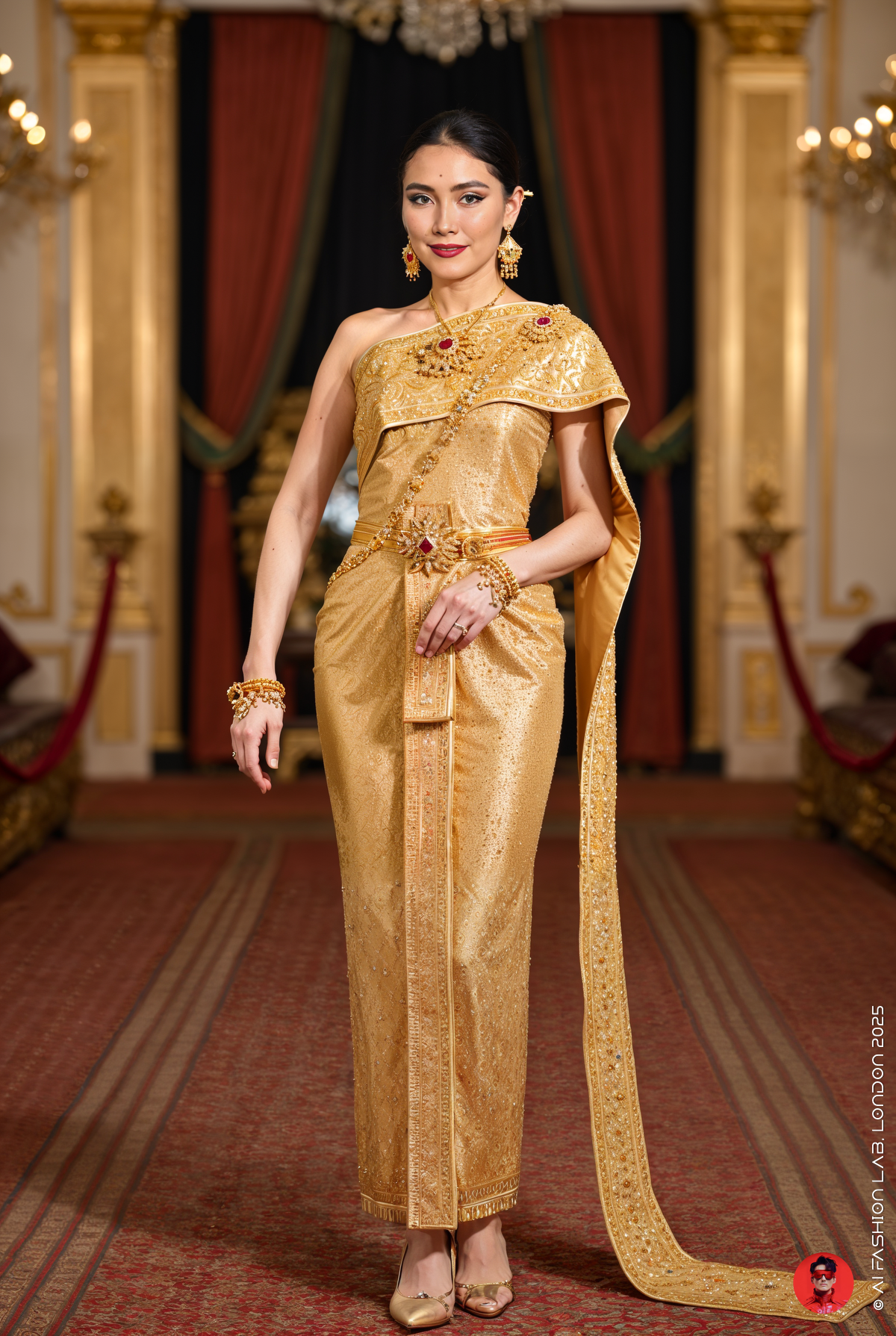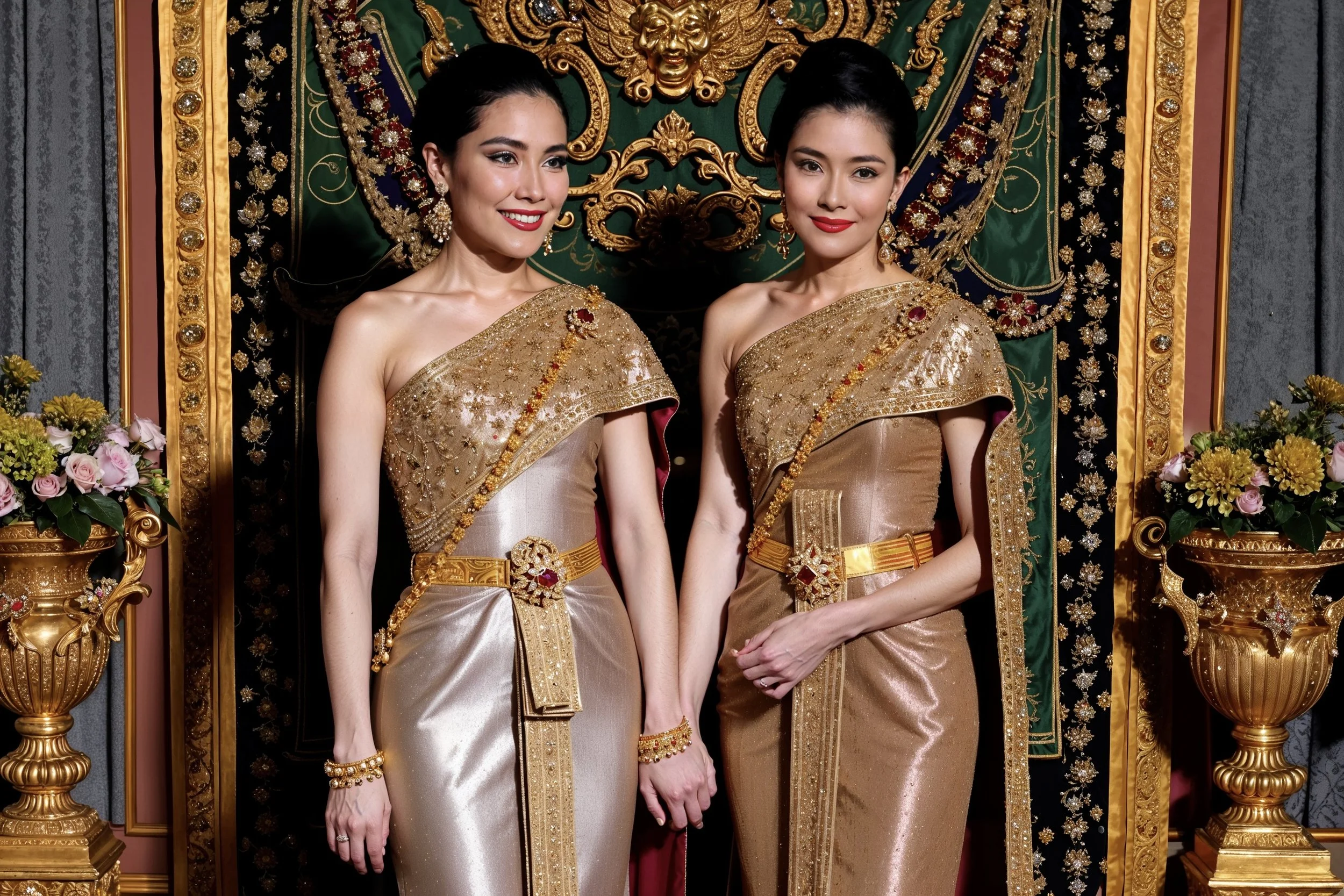ชุดไทยจักรี ชุดไทยพระราชนิยม เครื่องแต่งกายประจำชาติและความภาคภูมิใจในความเป็นไทย (๕ ใน ๘)
ชุดไทยจักรี ชุดไทยพระราชนิยม เครื่องแต่งกายประจำชาติและความภาคภูมิใจในความเป็นไทย
(ชุดแบบที่ 5 จากทั้งหมด 8 แบบในชุดไทยพระราชนิยม)
ชุดไทยจักรี เป็นหนึ่งใน ชุดไทยพระราชนิยม ซึ่งสมเด็จพระนางเจ้าสิริกิติ์ พระบรมราชินีนาถ พระบรมราชชนนีพันปีหลวง ทรงพระกรุณาโปรดเกล้าฯ ให้รังสรรค์ขึ้น เพื่อเป็นต้นแบบของการแต่งกายที่สะท้อนเอกลักษณ์ความเป็นไทยอย่างวิจิตรบรรจง ทั้งยังกลมกลืนกับรสนิยมแบบสากลในยุคทศวรรษ 1960 อย่างมีระดับ
ชุดไทยจักรี ประกอบด้วยสไบเฉียงที่ใช้ผ้ายกมีเชิง หรือผ้ายกทั้งตัว ซิ่นนุ่งจีบหน้ายก มีชายพก และคาดเข็มขัดไทย ส่วนท่อนบนเป็นสไบซึ่งอาจเย็บติดกับตัวซิ่นเป็นชุดเดียว หรือแยกออกเป็นผ้าสไบห่มต่างหากก็ได้ โดยจะเปิดบ่าข้างหนึ่ง และชายสไบคลุมไหล่ ทิ้งชายด้านหลังยาวตามความเหมาะสม จุดเด่นของชุดอยู่ที่คุณภาพของเนื้อผ้า ความประณีตในการตัดเย็บ และรูปทรงที่ขับเน้นความงดงามของผู้สวมใส่ เหมาะอย่างยิ่งสำหรับสวมใส่ในงานเลี้ยงฉลองสมรส หรือราตรีสโมสรที่ไม่เป็นทางการ
ในต้นแบบดั้งเดิม เสื้อตัวในของชุดไทยจักรีจะไม่มีแขนและไม่มีคอ ห่มทับด้วยสไบแบบชายเดียว ปักดิ้นทอง ส่วนผ้านุ่งใช้ผ้าไหมยกดิ้นทองแบบ “หน้านาง” มีชายพก คาดเข็มขัด และประดับด้วยเครื่องประดับไทโบราณ เช่น สร้อยคอ รัดแขน และสร้อยข้อมือ เพื่อเสริมความสง่างามให้เหมาะสมกับโอกาส
สำหรับผลงาน AI Collection ชุดนี้ ผมได้ออกแบบชุดไทยจักรีโดยเลือกใช้ผ้าไหมปักดิ้นทองทั้งตัวในแบบเดียวกันเกือบทั้งคอลเลกชัน เสริมด้วยเครื่องประดับไทยโบราณและเทียร่าแบบตะวันตก เพื่อสะท้อนความอ่อนหวาน สุภาพ และสง่างามของผู้สวมใส่ เหมาะสำหรับโอกาสพิเศษยามค่ำคืน ทั้งในงานสมรสหรืองานราตรีที่ไม่เป็นทางการ
ชุดไทยจักรี จึงนับเป็นการผสมผสานอย่างลงตัวระหว่างความสง่างามของเครื่องแต่งกายไทยดั้งเดิม กับแนวคิดแบบร่วมสมัยในโลกสากล และยังเป็นต้นแบบที่เหมาะสมยิ่งสำหรับการสร้างสรรค์ด้วยเทคโนโลยี AI ภายใต้แนวคิด “ความสง่างามแบบวินเทจสไตล์ไทย” ซึ่งให้ทั้งกลิ่นอายแห่งอดีต ความร่วมสมัย และคุณค่าทางวัฒนธรรมอย่างแท้จริง
AI Collection ชุดนี้ได้รับแรงบันดาลใจจาก สมเด็จพระนางเจ้าสิริกิติ์ พระบรมราชินีนาถ พระบรมราชชนนีพันปีหลวง และ ชุดไทยพระราชนิยมทั้ง 8 แบบ ซึ่งทรงมีพระราชดำริจัดสร้างขึ้นระหว่างปี พ.ศ. 2503–2504 เพื่อให้สตรีไทยมีเครื่องแต่งกายที่สง่างาม สะท้อนเอกลักษณ์ของความเป็นไทย และเหมาะสมกับงานพิธีและโอกาสสำคัญต่าง ๆ
เพื่อเฉลิมพระเกียรติในพระราชดำริอันทรงคุณค่านี้ ผมจึงสร้างสรรค์ AI Collection ที่นำเสนอชุดไทยทั้ง 8 แบบผ่านมุมมองร่วมสมัย โดยผสมผสานกลิ่นอายแฟชั่นวินเทจแห่งยุค 1960s ซึ่งเป็นช่วงเวลาเดียวกับการกำเนิดของชุดเหล่านี้ ทั้งการจัดแสง ทรงผม และองค์ประกอบในภาพ ต่างได้รับการออกแบบอย่างประณีตเพื่อสะท้อนความงดงามของช่วงเวลาแห่งวัฒนธรรมไทยนี้อย่างสมบูรณ์
ในปีหน้า องค์การยูเนสโก (UNESCO) มีแนวโน้มจะขึ้นทะเบียน "ชุดไทยพระราชนิยม" เป็นมรดกภูมิปัญญาทางวัฒนธรรมของโลก โครงการนี้จึงมุ่งหวังที่จะเฉลิมฉลอง อนุรักษ์ และส่งต่อความภูมิใจในความเป็นไทยไปสู่คนรุ่นต่อไป
พระราชนิยมในการใช้ผ้าไทย: พระปณิธานของสมเด็จพระนางเจ้าฯ พระบรมราชินีนาถ
สมเด็จพระนางเจ้าฯ พระบรมราชินีนาถ ทรงมีพระราชนิยมในการใช้ ผ้าไทย มาตั้งแต่ยังทรงพระเยาว์ เมื่อครั้งสมเด็จพระเจ้าอยู่หัวมีพระราชดำริจะทรงประกาศหมั้น นักหนังสือพิมพ์ต่างประเทศได้ขอสัมภาษณ์พระองค์ ซึ่งพระองค์ทรงตอบอย่างชัดเจนว่า จะสนับสนุนและส่งเสริมการแต่งกายแบบไทย
ในโอกาสนั้น พระองค์ในฐานะ “พระคู่หมั้น” ทรงเลือกใช้ ผ้าไหมไทย และ ซิ่นไทย สำหรับชุดต่าง ๆ รวมถึง ฉลองพระองค์ในพระราชพิธีอภิเษกสมรส ก็ทรงใช้ผ้าไทยอย่างภาคภูมิ ภายหลังจากพระราชพิธีดังกล่าว พระองค์ทรงยึดมั่นในพระราชปณิธาน และทรงพระกรุณาโปรดให้สร้าง “เครื่องแต่งกายแบบไทยตามพระราชนิยม” ขึ้น จนกลายเป็น เครื่องแต่งกายประจำชาติของสตรีไทย มาจนถึงปัจจุบัน
ในสมัยที่เสด็จฯ เยือนประเทศเพื่อนบ้านเป็นครั้งแรก ยังไม่มีการกำหนดชุดไทยตามแบบพระราชนิยม พระองค์จึงทรงริเริ่มออกแบบฉลองพระองค์โดยใช้ ผ้าไหมไทย ผ้ายก และผ้าพื้นถิ่นไทย ต่าง ๆ มาตัดเย็บและประดิษฐ์ตกแต่ง เพื่อให้สื่อถึงอัตลักษณ์ของความเป็นไทย โดยทรงเจริญรอยตามสมเด็จพระพันปีหลวง สมเด็จพระศรีพัชรินทรา บรมราชินีนาถ
ชุดไทยพระราชนิยม
“ชุดไทยพระราชนิยม” หมายถึง ชุดแต่งกายประจำชาติของสตรีไทยที่ใช้ในงานพิธี งานมงคลสมรส และโอกาสสำคัญต่าง ๆ ชุดเหล่านี้มีลักษณะเฉพาะทางด้านรูปแบบ วัสดุ และการตกแต่ง โดยนิยมใช้ผ้าไหม ผ้าฝ้าย หรือผ้าใยประดิษฐ์ เช่น ผ้าพื้น ผ้าลายดอก ผ้าลายริ้ว ผ้ายกดิ้นเงิน ดิ้นทอง หรือผ้ายกดอกทั้งผืน พร้อมตกแต่งด้วยซิป ตะขอ หรือกระดุมที่หุ้มด้วยผ้า และอาจปักมุก เลื่อม หรือใช้ลูกปัดตกแต่งเพื่อเพิ่มความสง่างาม
ประเภทผ้าที่นิยมใช้ เช่น:
ผ้าไหม: ทอจากเส้นด้ายที่ได้จากใยไหม
ผ้าฝ้าย: ทอจากเส้นด้ายฝ้ายธรรมชาติ
ผ้าใยประดิษฐ์: ผ้าใยสังเคราะห์ เช่น โพลีเอสเตอร์ เรยอน เจอร์ซีย์ หรือโทเร
ชุดไทยพระราชนิยมทั้ง 8 แบบ ได้แก่
ชุดไทยเรือนต้น – เรียบง่าย เหมาะสำหรับงานไม่เป็นทางการหรือสวมใส่ในชีวิตประจำวัน
ชุดไทยจิตรลดา – สุภาพ เหมาะสำหรับงานพิธีการเล็กน้อยหรือรับรองแขก
ชุดไทยอมรินทร์ – งดงาม เหมาะกับงานราตรีหรืองานพิธีสำคัญ
ชุดไทยบรมพิมาน – ผ้าไหมลายสวย ใช้ในงานพิธีการและงานทางการ
ชุดไทยจักรี – หรูหรา สง่างาม เหมาะกับงานพิธีระดับสูง
ชุดไทยดุสิต – ใช้ผ้าไหมลวดลาย ปักลายวิจิตร สำหรับงานราตรีหรืองานฉลอง
ชุดไทยศิวาลัย – หรูหรา เน้นเครื่องประดับ ใช้ในงานพิธีสำคัญ
ชุดไทยจักรพรรดิ์ – สง่างามที่สุด ใช้ในงานพิธีใหญ่ระดับราชสำนัก
#aifashionlab #AI #aiartist #aiart #aifashion #aifashiondesign #aifashionstyling #aifashiondesigner #fashion #fashionhistory #historyoffashion #fashionstyling #fashionphotography #digitalfashion #digitalfashiondesign #digitalcostumedesign #digitaldesign #digitalaiart #ThaiFashionHistory #ThaiFashionAI
Chud Thai Chakri – Chud Thai Phra Ratcha Niyom – National Dress and a Symbol of Thai Identity
(Style No. 5 of the 8 official designs in the Chud Thai Phra Ratcha Niyom collection)
Chud Thai Chakri (ชุดไทยจักรี) is one of the distinguished styles within the Chud Thai Phra Ratcha Niyom (ชุดไทยพระราชนิยม), a series of eight formal Thai national costumes graciously initiated under the royal patronage of Her Majesty Queen Sirikit The Queen Mother. These designs were envisioned to celebrate Thai identity through exquisite traditional dress while aligning seamlessly with the global fashion aesthetics of the 1960s.
The Chakri style is defined by its one-shouldered sabai (shoulder cloth) made from brocaded silk, either with patterned borders (yok mi cheung) or woven motifs across the entire fabric (yok thang tua). The lower garment is a pha-nung (tube skirt) featuring jeeb na nang (front pleats) and chai pok (top pleats or a side-facing panel) secured with a traditional Thai belt. These distinctive pleats create a structured yet flowing silhouette that accentuates movement and grace.
The upper part consists of a sabai draped diagonally across the body, leaving one shoulder exposed. This sabai may be a separate piece worn over a sleeveless, collarless inner blouse, or sewn as one continuous garment with the skirt. The trailing end of the sabai drapes elegantly over the opposite shoulder, falling down the back with length adjusted to suit the formality of the occasion. The beauty of Chud Thai Chakri lies in the richness of its textiles, the finesse of its tailoring, and the elegant contour it gives to the wearer—ideal for evening events such as wedding receptions or semi-formal state functions.
Traditionally, the inner blouse is sleeveless and collarless, while the sabai is often embroidered with gold thread. The pha-nung is made from yok din thong—a brocade silk interwoven with gold thread, complemented by jeeb na nang pleating at the front and a softly trailing chai pok at the side. The ensemble is completed with classical Thai jewellery such as necklaces, armlets, and bracelets to enhance its regal refinement.
In this AI Collection, I have reimagined Chud Thai Chakri using coordinated gold-threaded brocade silk across most designs, complemented by traditional Thai jewellery and Western-style tiaras. This thoughtful pairing brings out the wearer’s soft elegance, composure, and timeless charm—perfect for celebratory evening occasions that call for understated grandeur.
Chud Thai Chakri represents a refined harmony between classical Thai aesthetics and modern international taste. Within the context of this AI-powered creative project, it offers a compelling canvas for digital reinterpretation under the theme of “Thai Vintage Elegance”—honouring cultural memory while embracing innovation.
This AI Collection draws inspiration from Her Majesty Queen Sirikit The Queen Mother and the full series of eight Chud Thai Phra Ratcha Niyom (ชุดไทยพระราชนิยม), which were developed under her royal initiative between 1960 and 1961. The goal was to create refined and graceful national attire for Thai women—garments that reflect Thai cultural identity and are appropriate for ceremonial functions and state occasions.
To honour this visionary royal initiative, I have created an AI Collection that reimagines all eight styles through a contemporary perspective. Each image is infused with the charm of 1960s vintage fashion—the era in which these national dresses first emerged. Lighting, hairstyle, and composition have all been meticulously crafted to convey the beauty of this cultural moment in Thai history.
Royal Patronage of Thai Textiles: Her Majesty’s Lifelong Commitment
Her Majesty Queen Sirikit The Queen Mother has embraced Thai textiles since her youth. When His Majesty King Bhumibol Adulyadej (Rama IX) intended to announce their engagement, foreign journalists interviewed Her Majesty, who expressed her firm commitment to promoting Thai dress.
At the time, as the royal fiancée, she chose to wear Thai silk and traditional Thai sinh in various ensembles. Notably, she wore Thai fabrics with pride during the Royal Wedding Ceremony. After the ceremony, Her Majesty continued to champion Thai textiles, graciously initiating the creation of the Chud Thai Phra Ratcha Niyom (ชุดไทยพระราชนิยม)—a series of formal national dresses for Thai women, now recognised as part of Thailand’s cultural identity.
During her first state visits to neighbouring countries, when no official Thai national dress had yet been established, Her Majesty began designing her formal attire using Thai silk, brocade, and regional Thai textiles. These designs reflected the essence of Thai identity and followed in the footsteps of Queen Saovabha Phongsri (Queen Sri Bajarindra), consort of King Chulalongkorn (Rama V), who had once served as Queen Regent.
Chud Thai Phra Ratcha Niyom (ชุดไทยพระราชนิยม)
Chud Thai Phra Ratcha Niyom refers to the formalised series of Thai national dresses for women, used in ceremonies, weddings, and official events. These garments are characterised by specific patterns, fabrics, and decorative details. Common materials include silk, cotton, and synthetic fibres, in plain colours, floral prints, stripes, or intricately woven patterns using metallic threads. Decorations may include fabric-covered buttons, zippers, or hooks, and sometimes delicate embellishments such as pearls, sequins, or beadwork.
Common fabrics used:
Thai silk – woven from natural silk fibres
Cotton – made from natural cotton threads
Synthetic fibres – such as polyester, rayon, jersey, or Toray
The Eight Styles of Chud Thai Phra Ratcha Niyom (ชุดไทยพระราชนิยม):
Chud Thai Ruean Ton (ชุดไทยเรือนต้น) – Simple, ideal for informal or everyday wear
Chud Thai Chitralada (ชุดไทยจิตรลดา) – Modest, suitable for semi-formal events or diplomatic receptions
Chud Thai Amarin (ชุดไทยอมรินทร์) – Elegant, appropriate for evening functions or formal ceremonies
Chud Thai Boromphiman (ชุดไทยบรมพิมาน) – Refined, typically made of patterned silk for ceremonial use
Chud Thai Chakri (ชุดไทยจักรี) – Luxurious and stately, ideal for high-level royal functions
Chud Thai Dusit (ชุดไทยดุสิต) – Decorated with intricate patterns, suitable for gala dinners or celebrations
Chud Thai Siwalai (ชุดไทยศิวาลัย) – Ornate and jewel-accented, designed for important royal ceremonies
Chud Thai Chakkraphat (ชุดไทยจักรพรรดิ์) – The most majestic, reserved for grand palace occasions
#aifashionlab #AI #aiartist #aiart #aifashion #aifashiondesign #aifashionstyling #aifashiondesigner #fashion #fashionhistory #historyoffashion #fashionstyling #fashionphotography #digitalfashion #digitalfashiondesign #digitalcostumedesign #digitaldesign #digitalaiart #ThaiFashionHistory #ThaiFashionAI












